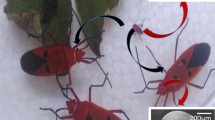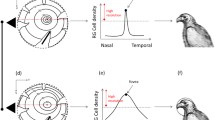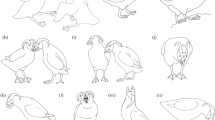Abstract
Gull-billed terns (Gelochelidon nilotica) were video-filmed while searching for and capturing fiddler crabs. Search consists of a vertical head nystagmus, with fast upward flicks and downward slow phases made at the angular speed of the substrate in the approximate direction of the bill. The bill points down at about 60° during hunting, but is brought up to 15° from time to time, which brings the visual streak into line with the horizon; 45° roll movements of the head are consistent with alternation between the use of the temporal and central foveas to view the same object. When a crab has been detected the nystagmus is suspended, and the tern tracks the crab continuously as it manoeuvres into a catching position. This may involve tucking the head under the body so that the bill is 45° behind the vertical, and flying up and backwards for some metres, straightening up the head at the same time.
Similar content being viewed by others
Author information
Authors and Affiliations
Additional information
Accepted: 7 November 1998
Rights and permissions
About this article
Cite this article
Land, M. The roles of head movements in the search and capture strategy of a tern (Aves, Laridae). J Comp Physiol A 184, 265–272 (1999). https://doi.org/10.1007/s003590050324
Issue Date:
DOI: https://doi.org/10.1007/s003590050324




